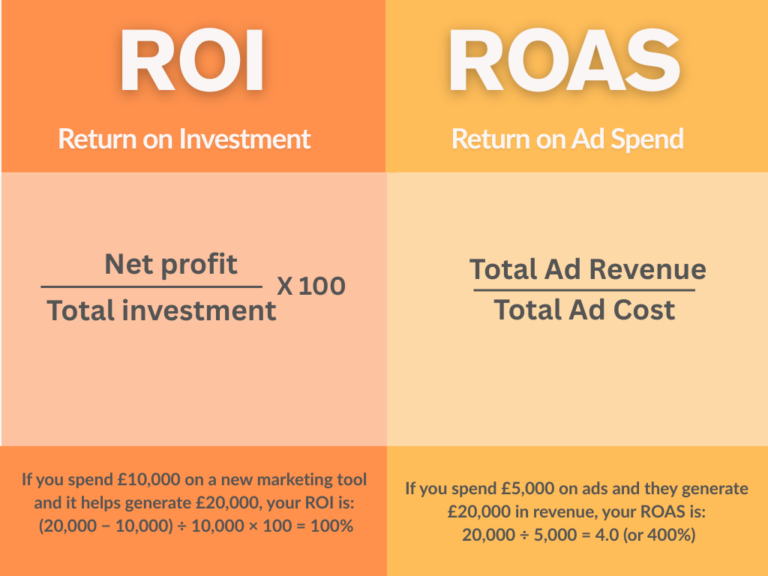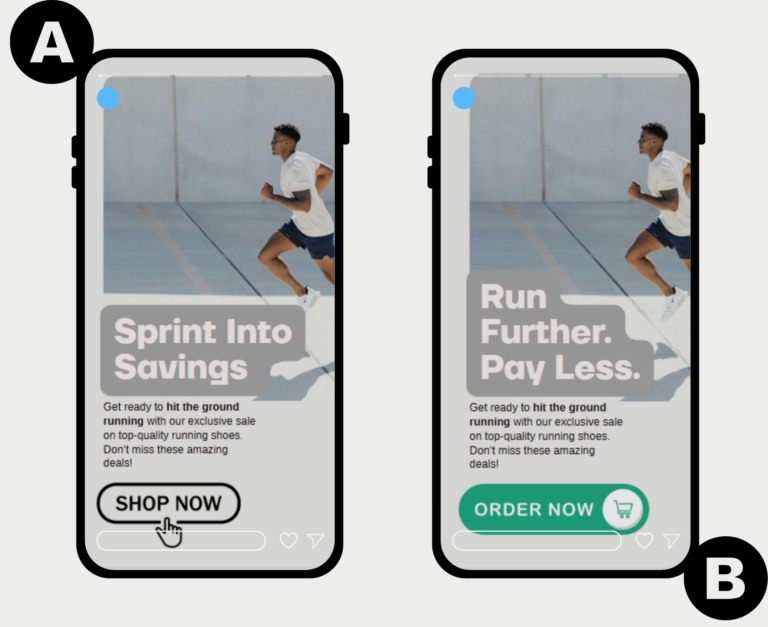Think of ROAS (Return on Ad Spend) as your marketing compass. It tells you how effective your advertising campaigns are and whether you’re getting the most out of your marketing efforts. But even with the best compass, it’s easy to head in the wrong direction
This guide will help you increase ROAS, take back control of your ad budget, and give actionable steps for implementing them.
What is ROAS, And Why is it Important?
ROAS is a key performance indicator in marketing. Rooted in the broader concept of return on investment (ROI), ROAS helps businesses assess if they’re making or losing money on their marketing campaigns.
Without tracking your ROAS, it can be tricky to know which channels are delivering the most value. Tracking your ROAS across advertising platforms such as social media and Google helps you see, in real time, where your ads are connecting with customers and encouraging them to take action.
This allows you to fine-tune underperforming areas and lean into what’s already driving results.
ROAS vs ROI
So, what sets ROAS apart from ROI?
Both metrics are used to measure profitability, however, they focus on different areas.
ROAS tells you how much revenue you earn for every pound spent on a specific ad campaign. The main focus is on campaign performance.
Whereas ROI measures the overall profitability of an investment by considering both revenue and all marketing-related costs, such as salaries and production. The focus is more on overall business profitability.
Calculating ROAS is a simple formula, it’s the total ad revenue generated divided by the total ad spend.

What Is a Good ROAS or ROI?
This is not a one-size-fits-all answer. As with most marketing metrics, it highly depends on your goals, industry, and market competition.
Google assumes that businesses make £2 for every £1 they spend, according to their economic impact report. However, this is dependent on your business goals; many businesses set their sights higher, sometimes aiming for 5:1 or more.
The same goes for ROAS. What counts as “good” can vary depending on things like profit margins and overhead costs. According to Varos, a market research platform, a good benchmark is a 4:1 ratio, which means £4 in revenue generated for every £1 spent on ads.
Advertising Strategies to Boost ROAS
When it comes to ROAS, you want the most bang for your advertising buck. Below, we’ve compiled tried and tested strategies to do just that.
1. Set ROAS Goals
The first step to any effective marketing strategy is to define goals. Your goals will be unique to your industry and audience. Having a clear list of goals helps you measure the success of your campaigns.
Campaign goals can vary and should be viewed in the context of broader business objectives and industry standards. For example, an ROAS of 4:1 might be seen as outstanding in one industry, but in another with higher profit margins, it could fall short of expectations.
Setting realistic and achievable ROAS goals starts with a solid understanding of your industry, competition, and product.
Here’s how to get started setting realistic ROAS goals:
Reviewing past ad performance data to set benchmarks for future targets.
Research industry ROAS benchmarks. For instance, E-commerce brands may aim for a 4:1 ROAS, while SaaS companies could require a lower ROAS due to their focus on customer lifetime value.
Factor in seasonal trends. For example, an E-commerce store may see higher ROAS around Black Friday or the holiday season, but lower performance in off-peak months.
Setting granular goals by channel or campaign. As an example, a campaign aimed at driving direct sales might aim for a ROAS of 3:1 or higher. That said, a product launch campaign may have differing goals.
Adjusting goals based on performance. To give you an idea, if a new Google Ads campaign has surpassed expectations, consider reallocating budget to scale its impact.
Ensure goals are in alignment with broader business goals. For instance, a startup SaaS company might accept a lower ROAS to grow its user base, while an established brand may prioritise profitability with higher ROAS expectations.
2. Refine Target Audience
Audience segments help you show the right ads to the right audience at the right time, which gives you a higher chance of conversion rates. That’s because audience segmentation allows you to deliver tailored messaging based on demographics, purchase history, interests, and lifetime value.
Here’s how:
1. Conduct market and audience research to identify your segments and ideal customers.
Demographics: Based on factors such as age, disposable income, and family status. For example, targeting young professionals with higher disposable income who are likely to spend on premium tech
Purchase history: Segmenting users based on what they’ve bought before helps tailor your offers. For instance, if a customer frequently buys skincare products, you could target them with similar product lines.
Lifestyle: Interests, values, and hobbies can indicate preferences. For instance, a person showing interest in fitness may be interested in sports gear.
Life events: Target users when they reach life milestones. For example, people who have just graduated from university or have just bought a house will likely need affordable furniture.
2. Develop buyer personas based on each segment. Include demographic information, buying motivation, and pain points.
3. Form your ad strategy around the above information, and tailor messaging to each segment
4. Monitor campaigns and use data to adjust them according to your audience preferences. Regular monitoring ensures your ads stay relevant as audience preferences evolve.

3. Tailor Ad Campaigns to Each Marketing Channel
If your advertising budget allows it, using a multi-channel approach offers unique opportunities for engagement. Thereby, allowing companies to tailor their messaging and interactions to each platform and stage of the customer journey. This approach can increase brand visibility and higher conversion rates.
An example of tailoring messaging to multiple channels to the customer journey might look like using Meta at the awareness stage and Google Search ads targeted to the consideration stage, where users are likely comparing features and prices.
Coupling a combination of both paid and organic marketing methods can create a sustainable strategy, maximising reach through paid ads while building long-term trust through organic content.
Hiring a paid ads agency can help take the guesswork out and ensure every part of your strategy is working together to drive measurable results.
4. Select High-Impact Ad Platforms
Each platform serves a different purpose depending on your goals and audience. Whether you use a single or multi-channel approach will depend on your industry and budget.
Here is a list of the most commonly used paid advertising marketing channels:
Search engine marketing, such as Google Ads and Bing Ads.
Best for: finding potential customers who are actively searching for solutions you offer. For example, if a user was searching ‘best CRM for small businesses’, they are already considering purchasing, so a relevant ad showing on search engine results matching that search can influence their final decision.Social media platforms such as Meta Facebook, Instagram, and LinkedIn.
Best for: building brand awareness, audience targeting, and reaching new customers based on their interests, behaviours, or job roles. LinkedIn is best for B2B lead generation, whilst Meta is great for targeting strategies.Display ads appear on websites that align with the advertiser’s target audience.
Best for: increasing brand visibility, retargeting previous site visitors, and keeping your product or service top of mind through visual reminders.Native ads are similar to display ads but blend in more with surrounding content and can appear less ‘salesy’.
Best for: engaging users in a more non-disruptive way, especially effective for content-driven campaigns like blog posts, guides, or product recommendations.YouTube ads appear before, during, or after videos and can also show up in search results on the platform.
Best for: grabbing attention with video storytelling, product demonstrations, or testimonials, ideal for brand awareness and reaching users across different stages of the funnel.
5. Improve Ad Creative & Messaging
Your ad’s success boils down to two things: what people see and what they hear.
Eye-catching, creative, and compelling ad copy is the cornerstone of conversion.
Focus on Ad Copy
Relevant and engaging content is essential for capturing the interest of your target audience.
Relevant keywords play an important part in ensuring your business offerings show up in relevant searches, to show your product or service as the solution to their problem.
Use clear language in your call to action to encourage users to take a specific action. For instance, ‘Sign Up Today’ or ‘Learn more’.
Make sure your call to action takes the user to the desired page, and that your landing page matches the offer in your ad. (For more information on how to do this, you can download our 2 optimisation checklists that go over how to tailor your landing pages for maximum conversions.)
Improve Your Visuals
Use visual cues like arrows, lines, or shapes to guide the viewer’s attention toward your call-to-action naturally.
Highlight elements with bold, contrasting colours to make them eye-catching.
Use high-quality images and attention-grabbing videos, whilst ensuring brand consistency (colours, fonts, logos).
6. A/B Testing
A/B testing takes the guessing out of what works. It involves comparing two versions of a campaign or a specific element of your ad, such as the headline, visual, or call-to-action. It helps businesses minimise the risk of running ads that don’t resonate with their audience, thereby resulting in wasted ad spend.
Here’s how:
Define the goals of your ad to track success. For example, to increase your ad click-through rate or increase product sales.
Form a hypothesis of what you predict the potential outcome will be. For example, if you want to increase sales, your test hypothesis may be ‘changing the headline will grab attention and lead to more sales, or a short video instead of static images will generate more interest’.
Create a duplicate ad, changing only one element to test. If you hypothesised that a different headline would generate more sales, then create an A and B variant with different headlines.
Define the parameters of your testing, which entails deciding how long your campaign will run for, whether you’re testing a specific audience segment, and how you want to split your audience.
Analysing the metrics relevant to your variable will tell you which variant was most successful. These results can tell you a lot about which campaigns resonated most with your audience segments and which elements get the most engagement.

Making the Most Out of Your Budget Allocation
At the end of the day, maximising your ROAS isn’t just about throwing money at ads and hoping for the best.
Navigating the ever-changing world of digital marketing can feel like trying to decode the Matrix…without the cool sunglasses.
You don’t have to be Neo to run paid ads that perform. Hiring a paid ads agency that understands your industry, knows who you’re trying to reach, and knows the ins and outs of creative that converts can make the most out of your ad spend. If that sounds like what you’re after, let’s chat.